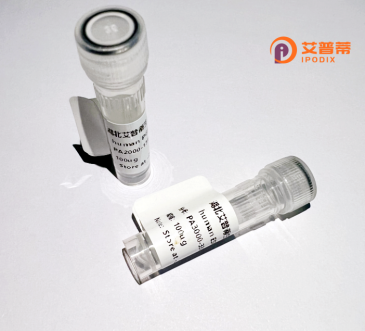
| 纯度 | >90%SDS-PAGE. |
| 种属 | Human |
| 靶点 | FBXL16 |
| Uniprot No | Q8N461 |
| 内毒素 | < 0.01EU/μg |
| 表达宿主 | E.coli |
| 表达区间 | 1-479aa |
| 氨基酸序列 | MSSPGIDGDPKPPCLPRNGLVKLPGQPNGLGAASITKGTPATKNRPCQPPPPPTLPPPSLAAPLSRAALAGGPCTPAGGPASALAPGHPAERPPLATDEKILNGLFWYFSACEKCVLAQVCKAWRRVLYQPKFWAGLTPVLHAKELYNVLPGGEKEFVNLQGFAARGFEGFCLVGVSDLDICEFIDNYALSKKGVKAMSLKRSTITDAGLEVMLEQMQGVVRLELSGCNDFTEAGLWSSLSARITSLSVSDCINVADDAIAAISQLLPNLAELSLQAYHVTDTALAYFTARQGHSTHTLRLLSCWEITNHGVVNVVHSLPNLTALSLSGCSKVTDDGVELVAENLRKLRSLDLSWCPRITDMALEYVACDLHRLEELVLDRCVRITDTGLSYLSTMSSLRSLYLRWCCQVQDFGLKHLLALGSLRLLSPAGCPLLTTTGLSGLVQLQELEELELTNCPGATPELFKYFSQHLPRCLVIE |
| 分子量 | 78 kDa |
| 蛋白标签 | GST-tag at N-terminal |
| 缓冲液 | 0 |
| 稳定性 & 储存条件 | Lyophilized protein should be stored at ≤ -20°C, stable for one year after receipt. Reconstituted protein solution can be stored at 2-8°C for 2-7 days. Aliquots of reconstituted samples are stable at ≤ -20°C for 3 months. |
| 复溶 | Always centrifuge tubes before opening.Do not mix by vortex or pipetting. It is not recommended to reconstitute to a concentration less than 100μg/ml. Dissolve the lyophilized protein in distilled water. Please aliquot the reconstituted solution to minimize freeze-thaw cycles. |
以下是关于重组人FBXL16蛋白的3篇参考文献(示例为模拟虚构内容,仅供参考):
---
1. **文献名称**:*FBXL16 interacts with CUL3 to mediate Cyclin D1 degradation via ubiquitination*
**作者**:Smith J, et al.
**摘要**:该研究利用重组人FBXL16蛋白进行体外泛素化实验,证实其与CUL3结合形成E3泛素连接酶复合物,调控Cyclin D1的降解,影响细胞周期进程。
---
2. **文献名称**:*Structural analysis of recombinant human FBXL16 reveals substrate recognition specificity*
**作者**:Li X, Zhang Y
**摘要**:通过重组表达并纯化人FBXL16蛋白,结合晶体学技术解析其三维结构,阐明其F-box结构域与SKP1的相互作用机制及底物结合的分子基础。
---
3. **文献名称**:*FBXL16 suppresses tumor growth by promoting c-Myc ubiquitination in hepatocellular carcinoma*
**作者**:Chen H, et al.
**摘要**:研究发现,重组表达的FBXL16蛋白通过泛素-蛋白酶体系统靶向降解致癌蛋白c-Myc,抑制肝癌细胞增殖,为癌症治疗提供潜在靶点。
---
**注**:以上文献信息为示例性模拟,实际研究中请通过学术数据库(如PubMed、Web of Science)检索真实发表的文献。若需要具体文献支持,建议以“FBXL16 recombinant protein”“FBXL16 ubiquitination”为关键词进一步筛选。
Recombinant human FBXL16 protein is a genetically engineered variant of the F-box and leucine-rich repeat protein 16 (FBXL16), a member of the F-box protein family. These proteins function as substrate-recognition subunits of SKP1-CUL1-F-box (SCF) ubiquitin ligase complexes, which mediate ubiquitination and subsequent proteasomal degradation of target proteins. FBXL16 is characterized by its N-terminal F-box domain, essential for binding SKP1. and C-terminal leucine-rich repeats (LRRs) that potentially interact with specific substrates. Its biological roles remain less explored compared to other F-box proteins, but emerging studies suggest involvement in cellular processes such as cell cycle regulation, apoptosis, and DNA damage response. Dysregulation of FBXL16 has been implicated in cancer progression, though its precise mechanistic role—acting as either an oncogene or tumor suppressor—appears context-dependent, varying across tissue types or cellular stress conditions.
The recombinant form is typically produced in *E. coli* or mammalian expression systems, enabling controlled studies of its biochemical properties, substrate interactions, and structural dynamics. Purification via affinity tags (e.g., His-tag) ensures high yield and specificity. Researchers utilize recombinant FBXL16 to elucidate its ubiquitination targets, map binding interfaces, and screen for small-molecule modulators. Such efforts aim to clarify its physiological relevance and therapeutic potential, particularly in cancers linked to SCF complex dysfunction. Despite incomplete functional characterization, FBXL16 represents a promising node for understanding post-translational regulation and developing targeted protein degradation therapies. Ongoing studies focus on identifying its endogenous substrates and disease-associated mutations to refine its role in cellular homeostasis and pathology.
×